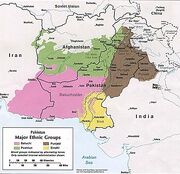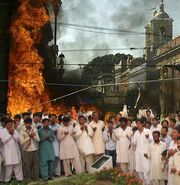| |||||||
| Capital | Islamabad | ||||||
| Largest city | Karachi | ||||||
| Other cities | Lahore, Peshawar, Quetta, Sukkar | ||||||
| Language official |
Urdu | ||||||
| others | Pashto, English, Punjabi, Sindhi, Balochi | ||||||
| President | Sardar Farooq Ahmad Khan Leghari (Urdu: سردار فاروق احمد خان لغاری) | ||||||
| Sharia Ulama | Syed Murtaza Amin Shah | ||||||
Pakistan (Urdu: پاکستان), officially the Islamic People's Republic of Pakistan (Urdu: اسلامی عوامی جمہوریہ پاکستان), is a fundamental Islamic theocratic country in Asia.
History[]
Before Doomsday[]
India and Pakistan in 1979 had another military confrontation over the Kashmir "Question". India also had several confrontations with China over the same area.
In 1983 the major issue in this area was the USSR's war within Afghanistan. Pakistan was aiding the various factions within Afghanistan along with Iran aiding those fighting the Russians. There was also covert help coming from the United States and the United Kingdom in the form of small arms and money. Also in 1983, India had tested at least three nuclear weapons. Pakistan, as of 1983, had received both design and materials from China for use in developing a nuclear weapon.

Major ethnic groups of Pakistan in 1980
Pakistan was also attempting to quell fighting within its northern tribal regions.
After Doomsday[]
Although Pakistan was spared the nuclear devastation, the event caused widespread confusion and panic. Despite the governments efforts to quell rioting and food shortages most Pakistani urban areas were in turmoil for most of 1983 and early 1984. During this period a young group of students from the International Islamic University began relief efforts throughout the capital territory, Islamabad, running relief convoys to rural areas to exchange medical supplies for food and then returning the food to urban areas. These efforts led to an end of the initial rioting. Local Mosques became central to these efforts. Soon much of the relief effort and organization of the student groups came under the oversight of the Mosque's Ulama Ulema.
Rise of the "White Shirts"[]
In late 1984 the student groups began formulating a more permanent solidity to their efforts. Organizing the several areas of their activity's into one umbrella group called; the al-Lawh al-Mahfūz society. The young men of the organization wore a clean white shirt as their uniform thus they became known as "The White Shirts". By 1986 there were at least 106 base's of operations of the White Shirts in Northern Pakistan. The Group became more and more politicized over the year culminating in the creation of the society's political wing; The Islamic People's Union, a combination of some military units in the north with their own group as well as dejected members of the Pakistani Muslim League. In June 1986 the Council of the IPU called for the end of martial law and the resignation of General Muhammad Zia-ul-Haq.
Election and Revolution[]

White Shirts outside Mosque
A referendum to set forth a new government was to be held on August 16 1986. The day before elections were to be held most of the bases of operations of the White Shirts were attacked by military forces. The attacks were devastating, The white shirts, basically a pacifist organization, were wholly unprepared for the violence that ensued. One student, Ali Muhammad O'Reilly Khan, stood before a burning Mosque formally a medical distribution center and began to recite the 99 names of Allah. He was joined by his fellows as well as citizens of the city. A radio broadcaster recorded the Nasheed, broadcasting it across Pakistan.
Conquest of Kashmir[]
In 1992, Pakistan took advantage of the political and economic situation in India by invading and assuming control over the formally Indian and Chinese administered areas of Kashmir. Pakistan did not invade further, fearing that the warring states of India would unite against them if they did.
Recent history[]
On April 26th, 2009, Pakistani soldiers crossed the border into the lawless region of Afghanistan. A representative of the Pakistani government said that the soldiers were sent to aide their Islamic brothers in bringing order to the state and impose the just law of Allah over the faithful once more. The Pakistani government hopes that if order can be brought to Afghanistan, it could be the start of a long term goal to unify the remaining Muslim population of the globe.
International relations[]
Pakistan is a member of the League of Nations. Pakistan has always been an ally of the Indian break-away states, especially Khalistan. Though Pakistan tried to stay out of the "international power blocs" until the new millennium, what it sighted as a "second Cold War", it gradually drifted towards the SAC as India got closer to the ANZC. Pakistan is currently a strong ally of the SAC and it has decided to militarily back Pakistan if India attacks.
| ||||||||||||||||||||||




